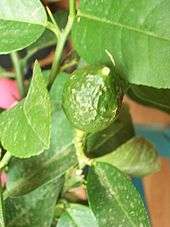Ponderosa lemon
| Ponderosa Lemon | |
|---|---|
 | |
| Scientific classification | |
| Kingdom: | Plantae |
| (unranked): | Angiosperms |
| (unranked): | Eudicots |
| (unranked): | Rosids |
| Order: | Sapindales |
| Family: | Rutaceae |
| Genus: | Citrus |
| Species: | C. limon × C. medica |
| Binomial name | |
| Citrus limon × Citrus medica (L.) Burm.f. | |
| Citron varieties |
|---|
| Acidic-pulp varieties |
| Non-acidic varieties |
| Pulpless varieties |
| Citron Hybrids |
| Related articles |
The ponderosa lemon (Citrus limon × medica) is a citrus hybrid of a lemon and a citron. It is not the same as the 'Yuma Ponderosa' lemon pomello hybrid, that is used as citrus rootstock.[1]
Description
Ponderosa lemon trees are slow growing but reach a height of 12 to 24 feet at maturity. The leaves are long, evergreen, glossy, and citron-like, being ovate elliptic in shape and lemon scented.[2] They have medium thick branches, that have many spines. New growth is purple tinged, as are the flowers.[3] Ponderosa lemon also has larger than average citrus flowers, and bears fruit throughout the year. When grown as an ornamental, pruning is required to control the shape, and may be trained as a bush or tree.
Ponderosa lemon is less cold hardy than a true lemon.[4] It bears medium to large fruit that have a thick and bumpy rind. The fruits are seedy, and while they look similar to a citron, they taste like a lemon.
Origin
The ponderosa lemon originated in roughly 1887, and is believed to come from a chance seedling grown in Hagerstown, Maryland. It was later named and introduced to the nursery trade in 1900.[2]
Uses

Ponderosa lemon is not widely grown commercially, but it is commonly grown as an ornamental plant. In areas where the winter's cold may damage the plant, they are grown in containers. In such cases they are usually grafted to dwarf rootstocks to help maintain a smaller, more manageable size. The impressive sized fruits may be left on the tree for many months after they've ripened without a drop in the fruits' quality. In addition, like citron, Ponderosa lemon trees can flower and bear fruit at the same time, further adding to the visual appeal.[5]
While the fruit are larger than that of a normal lemon, they have the same flavor and acidity. As such, the fruit can be used in place of true lemons. There is enough juice for several lemon pies in just one large Ponderosa lemon, and they can replace lemons measure for measure in recipes.[6]
References
- ↑ Yuma Ponderosa at Citrus Variety Collection
- 1 2 Reuther, Walter; Leon Dexter Batchelor; Herbert John Webber (January 1967). "Horticultural Varieties of Citrus". Citrus Industry: Crop Protection. Volume I: History, World Distribution, Botany, and Varieties (revised ed.). University of California.
- ↑ "Ponderosa lemon hybrid". Citrus Variety Collection. University of California Riverside: College of Natural and Agricultural Sciences.
- ↑ "Lemons". Home Fruit Production. Texas A&M University: Aggie Horticulture.
- ↑ Rodale, Jerome Irving (1971). The Encyclopedia of Organic Gardening. Rodale Books. p. 394. ISBN 0-87596-061-8.
The Ponderosa bears fruit and flowers simultaneously, which makes the plant interesting as well as attractive. The fruits last extremely well on the plant, and may be allowed to remain on it for months without danger of deterioration.
- ↑ Atta, Marian Van; Marlan Atta (2002). Exotic Foods: A Kitchen and Garden Guide (illustrated ed.). Pineapple Press Inc. p. 12. ISBN 1-56164-215-0.
| Wikimedia Commons has media related to Citrus 'Ponderosa'. |